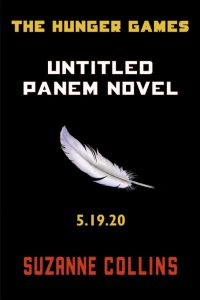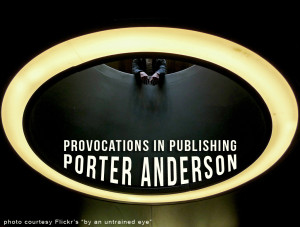The Hunger Games Takes Aim, Again
By Porter Anderson (@Porter_Anderson) | July 1, 2019 |

Image – iStockphoto: Kagenmi
Springtime for Scholastic
Here on the first day of July (rabbit!), you may have missed the news in the latter part of June that something tentatively called the Untitled Panem Novel is to be rolled out in print, ebook, and audiobook editions in the States, Canada, the UK, Ireland, Australia, and New Zealand on May 19 of next year– a nice big simultaneous release in many countries, something that’s beloved of us publishing internationalists.
 Do you know what Panem is? If so, then you know your Hunger Games. Panem is the post-apocalyptic nation featured in The Hunger Games.
Do you know what Panem is? If so, then you know your Hunger Games. Panem is the post-apocalyptic nation featured in The Hunger Games.
And in an understandably delerious news flash to the media, Scholastic has announced that Suzanne Collins’s new Hunger Games book is a prequel to the trilogy, the first book of which started reaching the reading public in 2008. Time flies like a Katniss arrow when your first book in a trilogy is on the Times bestseller lists for more than five years running.
The second book in the trilogy, Catching Fire (history’s most understated wink of a title), was out in 2009.
Mockinjay, the capper, came out in 2010.
So it will have been 10 years since the appearance of the third Hunger Games book when the new title arrives. Nostalgic, are you?
Scholastic is telling us that international rights for the trilogy have sold into 54 languages and 57 territories. In fact, the rights for the new prequel already are reported to have sold into Brazil, Israel, Norway, Spain, Slovakia, Germany, Hungary (no Hungary Games jokes, please), Finland, and France.
There are more than 100 million copies of the books from the trilogy out there. The four films have pulled in almost $3 billion since the first one went to the cinemas in 2012.
And the reason I’m going on about Collins’ work and the upcoming prequel–which is set 64 years before the trilogy on the morning of the reaping of the 10th Hunger Games–has a lot to do with a book market that has needed some YA crossover energy for a while. Badly.
It was during the long-running popularity of The Hunger Games that Nielsen first revealed data indicating that an astonishing 80 percent of YA titles were being bought for consumption by adults.
This is one reason that a lot of people may feel cheered by a new arrow from Collins’ quiver. As BookScan research (formerly a Nielsen product, now owned by NPD) revealed at BookExpo, the bestselling genres in adult divisions this year are general fiction and suspense/thrillers. Romance came in third in the first quarter of this year. In kids’ and YA titles, the best 2018 fiction sales seen in general fiction, sci-fi, and fantasy.
All of which indicates that action-adventure/fantasy/thriller-driven material like that Collins creates can still find a lot of traction, particularly among the Panemites of our readership.
What’s more, while nonfiction may still be hitting more growth charts than fiction these days, NPD did see a distinct fall-off in the first quarter in political book sales. (That caused a nearly audible gulp from publishers at BookExpo who had just signed new political books.) A slacking-off in the sector isn’t yet known to be long-term yet, mind you. But should it tend to linger in the US market data for more of the year, it’s expected to be put down to political fatigue. This could mean that more readers by next spring will be ready for some other kind of dog-eat-dog entertainment than the stuff Washington keeps offering us.
It was amusing last week, as the Democratic candidates’ debates were coming, to hear one news analyst on CNN predict that the second night of the debates would be “like The Hunger Games.” (She was rather right, too.)
But this is where I’d like your input. My provocation for you today: is the coming new book good news for publishing on the wider scale?
Taking Aim

Provocations graphic by Liam Walsh
While a single title does not a turnaround make, if Collins and Scholastic can hit the target again with the accuracy of the original trilogy, then several things can be expected to happen, such as:
- New titles from other authors and publishers that tug at the bowstrings of fond Hunger fans will be everywhere;
- We may see another round of engagement not only from YA-age readers but also from those politics-pummeled adults (who will tell you they’ve bought the Collins for the kids, of course); and
- Blockbuster obsession will put too much attention on this one piece, count on it, but it should at least tip things across the board slightly toward frontlist, while backlist has been leading, even more in children’s/YA than in adult fiction.
In general, there might even simply be a books-benefitting aura around interest in this new work, especially in the YA-crossover range of material that’s so readily and profitably adapted to the screens. With so much content going into development for the streamers, in fact, I’d say there’s a good chance this time around that Collins’ new book spins off not a film deal but a series–an expensive one sustaining several seasons, for a big, beautiful audience hungry for it, from Tokyo to Tashkent.
In a prepared statement from Collins, she’s quoted, saying, “With this book, I wanted to explore the state of nature, who we are, and what we perceive is required for our survival. The reconstruction period 10 years after the war, commonly referred to as the Dark Days—as the country of Panem struggles back to its feet—provides fertile ground for characters to grapple with these questions and thereby define their views of humanity.”
Dark Days, huh? Relevance to our current divisiveness, anyone?
In the publisher’s statement, we read Ellie Berger, who heads up Scholastic’s trade division, saying that the company is looking forward to introducing “the devoted fans of the series and a new audience to an entirely new perspective on this modern classic.” And if anybody can float some major boats, it’s Collins.
But, then, many of our readers here at WU have seen surprise hits and sure-thing disasters in the past. And I’d like your input on what it might mean that the House of Potter is about to offer a new book of Games.
Weigh in if you like. And if you’re too busy suddenly trying to outline something about good-looking teens who find themselves in woodland settings under violent circumstances, I’ll understand of course. I’ve already called your publisher and told them it’s coming.
[coffee title=”Wish you could buy Porter a glass of Campari?” icon=”glass”]Now, thanks to tinyCoffee and PayPal, you can![/coffee]









I don’t have much to say on this, Porter, other than that it’s great to see/read you because I always learn from your posts. You provide a window into a side of publishing with which I’m woefully unfamiliar. I look forward to seeing what others have to say and learning even more today.
My writing buddy and I have been debating whether anyone should be releasing books in September/October 2020 or whether the entire news cycle and all the air in the media room will be sucked up in the election. With a 5-19 release date, Collins will be out long before this but it will be interesting to watch whether, as you say, it’s a horrible time (fall) to be releasing or whether a good escapist book will add needed respite to weary readers.
I confess I have never read any of the Hunger Game books. My penchant is for reading about the world I live in, though many of my friends have read every word Collins has to offer. For me what fills the news media now reaches beyond the comfortable, so when I have time to read a book, I want to be taken to another place. That’s not to say I want only romantic encounters or everything with a tidy ending. This week it’s An American Marriage by Tayari Jones and last week it was Between the World and Me by Ta Nehisi Coates and those books offer plenty of societal upheaval for me. Always good to see you, Beth
“An astonishing 80 percent of YA titles were being bought for consumption by adults.”
For me, that’s what deserves special note in Anderson’s post. Goodbye Saul Bellow, Catherine Anne Porter, John Updike, and all the others who made successful careers by writing for card-carrying adults. Move them to the curb, and say hello to books targeting the simplified, digitized consciousness of What’s Happening Now. I don’t fault Collins or others like her. They are just successfully exploiting the moment. I don’t fault anyone. But I do lament what used to be called “literary values” being replaced by the skillful manipulation of formulas aimed at that 80 percent.
Barry…sorry, I’m stirred up by several comments here today, which I suppose is Porter’s purpose.
To your comment, fable-like tales have had appeal as long as tales have been told. I can’t agree that they are somehow lesser or less literary. Beowulf. Dante. Jonathan Swift. George Orwell. Richard Bach.
Okay, maybe I’m stretching a bit with Jonathan Livingston Seagull, but perhaps you get my point? The type of literary values that I believe you’re thinking of arose with the “realism” of the mid-Nineteenth Century. Stendhal. Pushkin. George Elliot. William Dean Howells.
Not that there’s anything wrong with that, but it’s not the only manner of storytelling that can be powerful.
Novels that capture the cultural mood and anxieties, and which feature young people, thereby elevating the danger, did not begin with The Hunger Games.
Lord of the Flies did the same thing in the post-war world. What did not happen then were a trilogy with prequels. Queen of the Bees. King of the Snakes. Before the Garden.
Is the new HG prequel good news or bad news? To me it says that we have not yet reached a new era of cultural anxiety that is different enough to generate its own Lord of the Flies or Hunger Games. But that will happen.
It always does, and when it does the book will be there, as will print publishing to deliver it to us in 57 languages. Thank God.
Let’s keep our fingers crossed for this one because it’s somewhat of a litmus test. The past decade has seen the explosive rise of the smartphone with access to social media and a zillion other apps. Ever present in the hands of today’s tweens, teens, and 20-somethings, these devices have had a huge impact on how and what “kids” consume for entertainment. Books? What are those? Perhaps Collins should have delivered the story as a “text message narrative” on YouTube.
Ali, if I may jump in as an insider who closely follows industry statistics…the fear that “kids today” are all electronic and do not read, let alone books, is untrue. YA and MG publishing have until the last year or two been the greatest area of growth for trade publishing for almost 20 years.
Conversely, e-book sales in the YA and MG categories are among the weakest is overall e-books sales. We are in no danger of losing reader kids who will grow up to be reader adults. The recent leveling off of YA and MG sales has more to do with the lack of blockbusters like Harry Potter, Twilight or Hunger Games–which have plenty of adult appeal–as anything.
Lest you think that print publishing overall is any danger, it’s not. More and more, the data suggests that e-books (which have leveled off definitively) appeal to consumers far more because of price point than because they are, per se, electronic. And the trade book industry (consumer books sold in bookstores) is healthy and growing. Indeed, last year it was the strongest arm of publishing overall.
So, sorry, the woe is unwarranted. As long as there are great stories, there will be people eager to read them–and on paper.
My teen granddaughter loves Harry Potter and asks for every hardback edition. She’s fortunate to have grandparents who are eager to fulfill her wishes–keep those bookshelves filled.
Donald,
All that being said about traditional print and e-books, I’m curious what your perspective is on the future of storytelling in the age of the smartphone. One can not deny the role these devices play in everyone’s lives and particularly the lives of teens and young adults.
I believe smartphone technology is giving rise to new formats for story delivery. The impact on television and film/video is obvious (YouTube, Netflix, Hulu), but it is also changing the world of the narrative in novel form (print and e-book). Examples of these new formats are: Snapchat, Instagram and Twitter stories (combos of visuals and text), “chat fiction” which has captured young horror/thriller and romance readers (good chat stories have millions of views/reads). Google recently released new technology called AMP Stories in collaboration with big media companies aimed at storytelling in advertising and journalism, but there is no reason this phone-friendly format can’t work for fiction stories.
From your business perspective, what are some promising online delivery formats for the future of the story that step outside the old-school novel format?